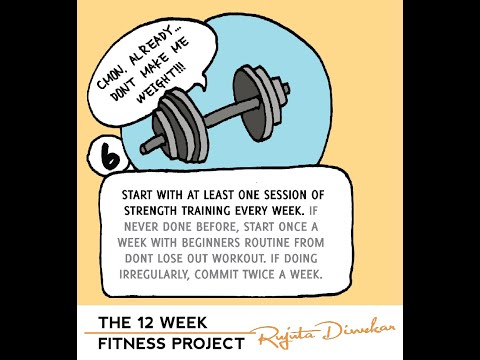
The fitness project 2018 – Week 6 guideline
This week’s guideline is a straight call from the heart – exercise. You know you should be doing it but you are still looking for a good time. Good time aa gaya.
There isn’t a person on earth who doesn’t want to lose weight. But to lose weight you have to gain weight – i.e lean body weight – the weight of your bones and muscles. Most of us lose between 2- 4 kgs of muscles every 10 years. In women, especially after 30, we lose muscle from our thighs and gain intramuscular fat at a fast pace.
This continuous and progressive loss of muscles and bone density can be reversed with exercise. Not just exercise actually, but a structured exercise.
And this is our guideline for week 6 – Start with atleast one session of strength training every week.
Here are some of the benefits from just one session of strength training a week –
• Prevents Diabetes and if you already have it, has the potential to get you on lowered dosages if not totally off medicines.
• Regulates period cycle and leads to pain free periods. Make conception easy if you want a baby.
• Reduces arthritic pain and uric acid.
• Reduces Blood pressure and resting heart rate.
• Improves functioning of the brain.
• Increases gait speed (can walk faster).
• Reduces depressive thoughts and improves sleep.
Notes on strength/ weight training –
1. If you have never weight trained before –
Start now. Schedule a meeting with an expert trainer at a local gym and begin with once a week routine. You can also use the beginner’s routine from ‘Don’t lose out, workout.’
You must especially start if you already have insulin resistance, are very obese, have a heart condition, bone loss or diabetes. That much more important for older adults (men and women).
2. If you are already training but are not regular –
Get regular and dedicate at least 2 times a week to strength training. This is especially crucial for all those who have PCOD, breakouts, menopausal or have thyroid. Focus on bringing in progressive overload into your workouts. Read more about it in the ‘Strength training’ chapter of ‘Don’t lose out, workout’ and follow the intermediate routine.
3. If you are training 3 or more days a week –
Shabash! Drop your reps to 5-8 and focus on the intensity or the actual weight you subject your muscles to (advanced routine from ‘Don’t lose out, work out’). The biggest gains of strength training come from the load bearing that you train your muscles to do.
FAQs on Exercise –
Q: I already do cardio/ swimming/ zumba/ dancing, etc, should I strength train?
A: Yes. And the reason is After burn –
Excessive Post exercise Oxygen Consumption (EPOC) or ‘After burn’ is a process that follows every session of strength training, where the body burns fat at a higher rate for upto 36-48 hrs. This is not the case with aerobic exercises where fat burn, if at all, happens only during the duration of exercise.
This is especially helpful for the obese or those suffering from hormonal imbalances due to excessive body fat.
Q: Is there an alternative to gym that we can do at home?
A: Two scenarios –
1. You have access but don’t want to go to gym because you are apprehensive/ shy/ don’t have time/ its too loud/ its for body builders only/ etc.
The benefits of weight training outweigh all of the above concerns. Working out in gym is the safest way to weight train as you can use machines and light weights (lighter than body weight) to train with a proper form. By gradually increasing weight, you can make progress in your strength. Follow the link below for videos on how to perform weight training exercises.
2. You don’t have access to a gym at all.
In that case, you can learn some basic strengthening exercises that use minimum or no equipment. Follow this link –
Q: I have just started weight training, my blood sugar levels are better, my thyroid is better, my jeans are getting loose, but I haven’t lost a gram, in fact I have GAINED a couple of kilos! ?:(
A: First things first, change that sad face to a broadly smiling one. Weight training increases fat-free weight, that of your bones and muscles. Obviously that’s going to mean some additional grams or kilos to your body mass. Not to forget the fact that as you start storing more muscle glycogen, it adds to body weight too.
Technically you can gain or lose up to five kilos of body weight without gaining or losing a single gram of fat. Body weight is no measure of fatness or fitness. Look at exercise performance instead; it’s the sure shot measure of your body’s fat-burning ability (health, fitness and risk to diseases). If you are pushing more weight, feeling more enthusiastic about exercise, looking forward to your routine in the gym, it means you are on track. That’s it.
Read the Strength training chapter here –
#RDfitnessproject2018 #Uncomplicatefitness






